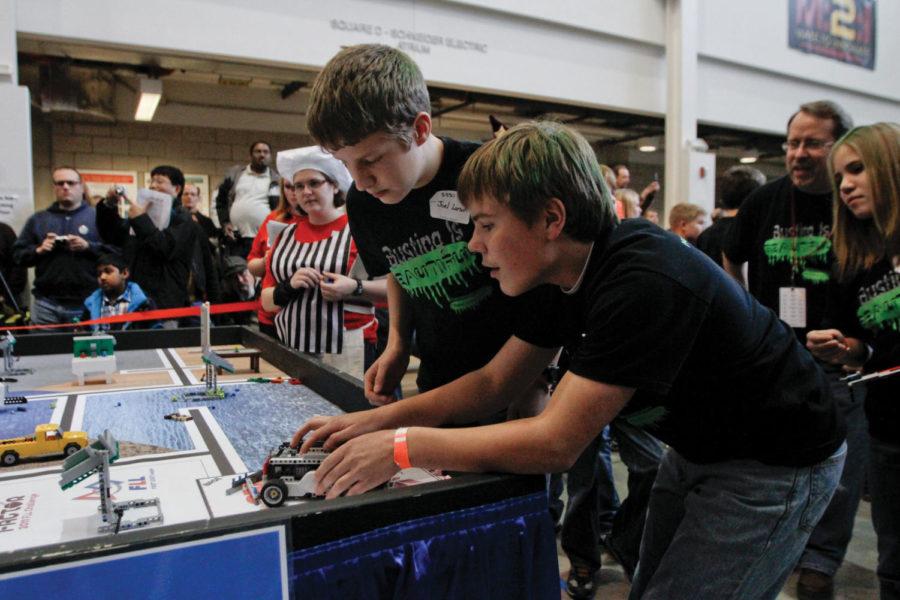FIRST Lego League team ‘busts’ food contamination problem
Members of the team Bacteria Busters compete in the FIRST Lego League competition in atrium of Howe Hall on Saturday, Jan. 14. Students ranging in age from 9 to 14 competed in the competition.
January 16, 2012
Fifth-grader Tyler Garten jumped up and down as his team’s Lego robot maneuvered its way around the specifically designed course. As the timer clicked down, Garten jumped quicker and quicker. The robot hit a contraption, causing Lego balls to drop into a compartment on the robot and Garten to rapidly clapped his hands.
“I was nervous,” Garten said after his team’s second match. “The first time didn’t go so well.”
Garten and his team Bacteria Busters competed in Iowa’s FIRST Lego League Championship on Saturday with 72 other teams. Bacteria Busters is composed of seven students, ranging from fifth to eighth grade, from Newton Christian School.
In a crowded Howe Hall, Bacteria Busters stood out as the only team with green hair. The team members chose to color their hair green to represent their solution to food contamination, this year’s FIRST Lego League’s theme.
“We colored our hair green to represent green fluorescent protein,” said Joel Larson, an eighth grader. “GFP is pretty much jellyfish goo.”
Bacteria Busters came up with their food contamination solution after taking a tour of a Hy-Vee store. They learned on their tour of the strict health practices grocery stores must abide by.
Mason Lee, a fifth grader, explained that the general store manager at Hy-Vee told Bacteria Busters that the store must throw away up to 500 pounds of food a year.
“It’s sad that they have to waste so much food,” said Duncan Lee, an eighth grader and Mason’s brother. “They don’t want to poison customers, but they also don’t want to waste food.”
After a lot of research, Bacteria Busters decided to choose GFP as their food contamination solution. Larson explained that GFP is a gene isolated from the Aequorea Victoria jellyfish species. He said grocery stores can inject GFP into a sample of food, illuminate the product with ultraviolet light and use photo recognition software to determine if the food is contaminated with dangerous bacteria.
“Grocery stores test food by time, temperature and appearance,” Duncan said. “GFP is more accurate because it actually can tell if there’s bacteria on the food.”
Bacteria Busters presented their food solution in a presentation that had the team members act out a scene in which the team went to a grocery store as part of the team’s fictional television show “Bacteria Busters.”
“I think our project went really well,” Larson said.
In addition to being judged on their research projects, Lego League teams also were evaluated on how they worked as a team and on the technical aspects of their robot.
“We look how they work together,” said Andy Marshall, sales manager at National Instruments and judge at the FIRST Lego League Championship. “Naturally, some kids work better than many adults do.”
Matthew Nelson, aerospace engineer at Iowa State, judged Bacteria Busters on the mechanical design and programming of the team’s robot.
“They had a good, organized program,” Nelson said. “They made good use of their sensors.”
At the end of the day, Bacteria Busters took home second place in programming. But, staying true to its message, FIRST Lego League isn’t about who wins or loses. It’s about the teams and their members learning more about science, technology and teamwork.
“They have to give a presentation, do research, work as a team,” said Kim Didier, Bacteria Busters’ coach and mother of three team members. “It’s a great learning experience.”







